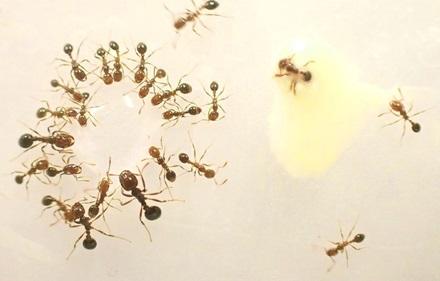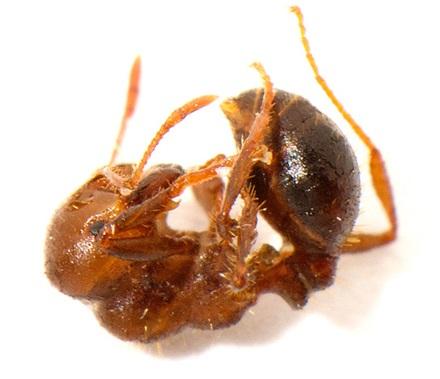Snake Venom: A Tell-tail Ant Repellent

A group of fire ants drink from a water droplet (on the left) while a few fire ants avoid the water droplet with snake venom (on the right). (Photo by Bob Vander Meer, ARS)
Snakes can be scary creatures. While snakes’ colorful skin patterns and menacing appearance are often enough to deter potential predators, those who become victims of snake attacks are unlucky to say the least. Some snakes defend themselves or attack prey by constricting their bodies to suffocate them, and others use their fangs to inject venom and paralyze or kill their attacker and victims.
A lesser-known technique that snakes use to defend themselves is secretion of foul-smelling toxins from the base of their tails. Researchers have known for decades that snakes’ tail secretions can act as a repellent, especially for ants. However, it has been unclear why all snake species, even those who do not interact with ants, produce these powerful toxins from their tails.
In a recently published paper, Robert Vander Meer, research leader for the Imported Fire Ant and Household Insects Research Unit at the Center for Medical, Agricultural and Veterinary Entomology in Gainesville, FL, and his research collaborator Paul Weldon of the Smithsonian's National Zoo and Conservation Biology Institute, studied ants’ reactions when encountering different snake secretions.
“In the study, we presented ants with two options: ordinary water and water tainted with snake secretions,” said Vander Meer. “The ants immediately consumed the ordinary water and knew to avoid any trace of snake secretions. When the ants did come in contact with the tainted water, they became paralyzed and most died within a few hours.”

A dead fire ant after it ingested water with snake venom. (Photo by Bob Vander Meer, ARS)
According to Vander Meer, the study’s findings are best explained by understanding the early history of these two foes.
Snakes and ants occupied the same underground environments over evolutionary time and became familiar with each other as neighbors typically do. The earliest snakes, which are most like the worm-like Texas blindsnake, had to protect and defend themselves from their intrusive neighbors, including aggressive ants. When stimulated, snakes can quickly distribute and cover their bodies with the defensive fluids through the action of writhing to avoid becoming a victim.
“By looking at the study’s results, we understand better the fascinating co-evolutionary history of snakes and ants,” said Vander Meer.
“Ants were the predators, and the snakes were the defenders. Even if snakes are not encountering ants in the wild, they still have a mechanism to protect themselves against a long-time foe.” — by Jessica Ryan, ARS Office of Communications.
###

